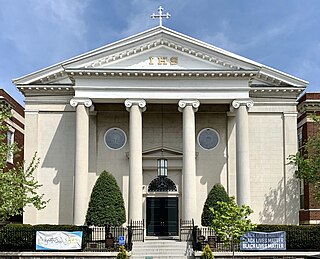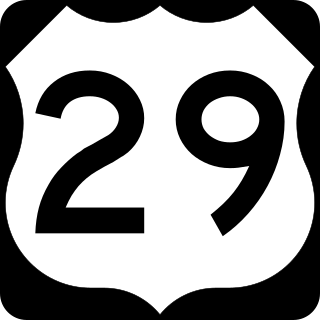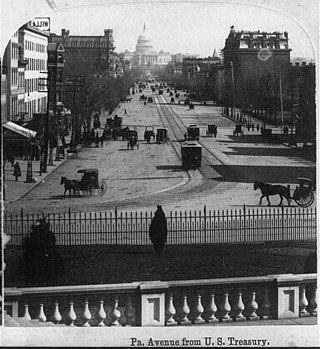
Pennsylvania Avenue is a diagonal street in Washington, D.C., and Prince George's County, Maryland, that connects the White House and the United States Capitol and then crosses Washington, D.C. before entering Maryland. In Maryland, it becomes MD Route 4 and then MD Route 717 in Upper Marlboro, and finally Stephanie Roper Highway. The section between the White House and Congress is sometimes referred to as "America's Main Street"; it is the location of official parades and processions, and periodic protest marches. Pennsylvania Avenue is an important commuter road and is part of the National Highway System.

Georgetown is a historic neighborhood and commercial district of Washington, D.C., in Northwest D.C., situated along the Potomac River. Founded in 1751 in the Province of Maryland, the port of Georgetown predated the establishment of the federal district and the City of Washington by 40 years. Georgetown remained a separate municipality until 1871 when the United States Congress created a new consolidated government for the whole District of Columbia. A separate act, passed in 1895, specifically repealed Georgetown's remaining local ordinances and renamed Georgetown's streets to conform with those in the City of Washington.

U.S. Route 240 is a defunct designation for a short, but once very important, segment of highway between Frederick, Maryland, and Washington, D.C. It is now commonly known as Wisconsin Avenue, Maryland Route 355, and Interstate 270 (I-270).

K Street is a major thoroughfare in the United States capital of Washington, D.C., known as a center for numerous lobbyists and advocacy groups. In political discourse, "K Street" has become a metonym for Washington's lobbying industry since many lobbying firms were traditionally located on the section in Northwest Washington which passes from Georgetown through a portion of Downtown D.C. Since the late 1980s, however, many of the largest lobbying firms have moved out; as of 2012, only one of the top-20 lobbying firms has a K Street address.

Northwest is the northwestern quadrant of Washington, D.C., the capital of the United States, and is located north of the National Mall and west of North Capitol Street. It is the largest of the four quadrants of the city, and it includes the central business district, the Federal Triangle, and the museums along the northern side of the National Mall, as well as many of the District's historic neighborhoods.

Friendship Heights is an urban commercial and residential neighborhood in northwest Washington, D.C., and southern Montgomery County, Maryland. Though its borders are not clearly defined, Friendship Heights consists roughly of the neighborhoods and commercial areas around Wisconsin Avenue north of Fessenden Street NW and Tenleytown to Somerset Terrace and Willard Avenue in Maryland, and from River Road in the west to Reno Road and 41st Street in the east. Within Maryland west of Wisconsin Avenue is the Village of Friendship Heights, technically a special taxation district.

Wesley Heights is a small affluent neighborhood of Washington, D.C. situated south of Spring Valley. Wesley Heights was founded in 1890 by a land speculation group led by John Waggaman and funded primarily by Charles C. Glover; Wesley Heights was further developed by the brothers William C. and Allison N. Miller during the 1920s. Modern-day Wesley Heights is bordered by Massachusetts Avenue, Nebraska Avenue, Battery-Kemble Park and Glover Parkway. Foxhall Road and New Mexico Avenue are the main roadway passing through Wesley Heights. To protect the character of the original historic housing design of Wesley Heights, the Wesley Heights Zoning Overlay was developed and approved by District of Columbia Zoning Commission on July 13, 1992, at the urging of the Wesley Heights Historical Society. Current homeowners and new housing development within the Wesley Heights overlay must meet specific building codes. The Wesley overlay covers areas west of New Mexico Avenue, Nebraska Avenue, Battery-Kemble Park and Glover Parkway. The overlay restriction does not cover development on housing located on the former Charles C. Glover country estate. Modern day Wesley Heights is located in Ward 3 Advisory Neighborhood Commission under 3D01.

The history of Washington, D.C., is tied to its role as the capital of the United States. The site of the District of Columbia along the Potomac River was first selected by President George Washington. The city came under attack during the War of 1812 in an episode known as the Burning of Washington. Upon the government's return to the capital, it had to manage the reconstruction of numerous public buildings, including the White House and the United States Capitol. The McMillan Plan of 1901 helped restore and beautify the downtown core area, including establishing the National Mall, along with numerous monuments and museums.

Massachusetts Avenue is a major diagonal transverse road in Washington, D.C., and the Massachusetts Avenue Historic District is a historic district that includes part of it.

Wisconsin Avenue is a major thoroughfare in Washington, D.C., and its Maryland suburbs. The southern terminus begins in Georgetown just north of the Potomac River, at an intersection with K Street under the elevated Whitehurst Freeway. The section of Wisconsin Avenue in Georgetown was called High Street before the street names in Georgetown were changed in 1895 to conform to those of the L'Enfant Plan for the federal city.

Streetcars in Washington, D.C. transported people across the city and region from 1862 until 1962.
The streets and highways of Washington, D.C., form the core of the surface transportation infrastructure in Washington, D.C., the federal capital of the United States. Given that it is a planned city, the city's streets follow a distinctive layout and addressing scheme. There are 1,500 miles (2,400 km) of public roads in the city, of which 1,392 miles (2,240 km) are owned and maintained by city government.

Holy Trinity Catholic Church is a Catholic church run by the Jesuit order that is located in the Georgetown neighborhood of Washington, D.C., in the United States. Holy Trinity Parish was founded in 1787 and is the oldest Roman Catholic community and house of worship in continuous operation both in Georgetown and in the larger city of Washington, D.C. The original church building was completed in 1794. It is now called the Chapel of St. Ignatius, and is used for smaller ecclesiastical celebrations and as an auxiliary space for parish activities. A larger church building, necessitated by the growing community, was dedicated in 1851, and still serves as the parish church today.

U.S. Route 29 (US 29) enters Washington, D.C., via the Francis Scott Key Bridge from Arlington, Virginia, and exits at Silver Spring, Maryland. It predominantly follows city surface streets, although the portion of the route from Key Bridge east to 26th Street NW is an elevated highway. The elevated section of U.S. Route 29 in D.C. is better known as the Whitehurst Freeway. Called the city's most ridiculed bridge in 1989, there have been several attempts to have the Whitehurst Freeway torn down but cost and other considerations have stopped these proposals from being acted on.
The Capital Traction Company was the smaller of the two major street railway companies in Washington, D.C., in the early 20th century. It was formed in 1895 through a merger of the Rock Creek Railway and the Washington and Georgetown Railroad Company. The company's streetcars connected the Washington, D.C., neighborhoods of Georgetown, Capitol Hill, the Armory, and Mount Pleasant; and the suburb of Chevy Chase, Maryland. In 1933, it merged with its major competitor, the Washington Railway and Electric Company, to form the Capital Transit Company.

The Washington and Georgetown Railroad Company was the first streetcar company to operate in Washington, D.C., United States. It was incorporated and started operations in 1862, using horse-drawn cars on tracks between Georgetown and the Navy Yard. Two additional lines ran on 7th Street NW/SW and 14th Street NW. In 1890, it switched to cable cars. On September 21, 1895, the company was purchased by the Rock Creek Railway and the two formed the Capital Traction Company.

The Pennsylvania Avenue Line, designated Routes 32, 34, and 36, is a daily Metrobus route in Washington, D.C., Operating between the Southern Avenue station or Naylor Road station of the Green Line of the Washington Metro and the Archives station of the Green and Yellow Lines of the Washington Metro or Potomac Park. Until the 1960s, it was a streetcar line, opened in 1862 by the Washington and Georgetown Railroad as the first line in the city.
The Washington Railway and Electric Company (WR&E) was the larger of the two major street railway companies in Washington, D.C., the capital of the United States, until 1933. At that time, it was merged with its main competitor, the Capital Traction Company, to form the Capital Transit Company. The WR&E's core was the Metropolitan Railroad, the second street railway in Washington, which had a main line zigzagging north of Pennsylvania Avenue on streets including F Street North, and it included many other lines in the city and into Maryland suburbs.















